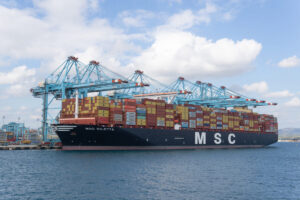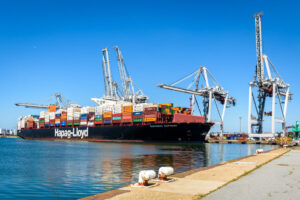Dwell time for Chinese exports has decreased 62 per cent year-over-year while volume of shipments from China to the US has declined 44 per cent year-over-year, according to a recent analysis.
FourKites, a leader in supply chain visibility, reported that the average days for Chinese exports in transit has significantly declined from a peak of 55+ days to less than 36 days.
However, this might begin to increase with reports of carriers slow steaming as capacity remains abundant.
Glenn Koepke, GM of Network Collaboration at FourKites, provided analysis on Chinese exports: “As the global economy has softened, ocean capacity is plentiful, though there is still significant activity in global supply chains.”
He added that shippers are weighing their options and determining what their inbound networks need to look like, including where global supply should come from.
READ: MSC reinstates China-North Europe trade connections
“We believe that China will always be a dominant player in global trade,” explained Koepke.
Despite this, FourKites has seen many shippers looking to Southeast Asia, India, and LATAM as alternatives while still keeping Chinese suppliers for the local market.
“Shippers, forwarders and BCOs know that we are one event away from chaos,” said Koepke.
So while supply chains are seeing easing demand and logistics professionals are relieved to have a slight mental break, Koepke believes that volume will pick back up as we head into peak season of Q3 and Q4.
READ: Decline in US-Asia imports challenges global container recovery
Koepke predicted four primary scenarios that will play out in the next seven months through the end of 2023:
- Looming COVID-19 effects that could shut down ports and disrupt trade.
- Ocean carriers will reduce capacity, cancel sailings and focus on staying profitable in 2023.
- A continued tap dance with the political impact and positioning of the Russian war. How China does or does not take action with Russia has a potentially catastrophic effect on their long-term role in global supply chains. Although the war has impacted certain commodities, Koepke feels that the real effect is on the lives lost on a daily basis and the infrastructure that will take generations to rebuild in Ukraine.
- Finally, Koepke believes volume will pick back up in Q3 and Q4. At the current pace, however, volume will be lower than 2022 which should equate to an easing of delays and available capacity heading into peak trade seasons.
Koepke also feels that 2024 will bring a major storyline with the US presidential election, along with how US companies and consumers view the next four years.
“Regardless of what party you support, a changeover in the US presidency can easily disrupt global trade through policy changes, tariffs and where infrastructure dollars go,” he explained.
Although the US presidential election is 18 months away, this is a major event all parties in global trade will have an eye on.











